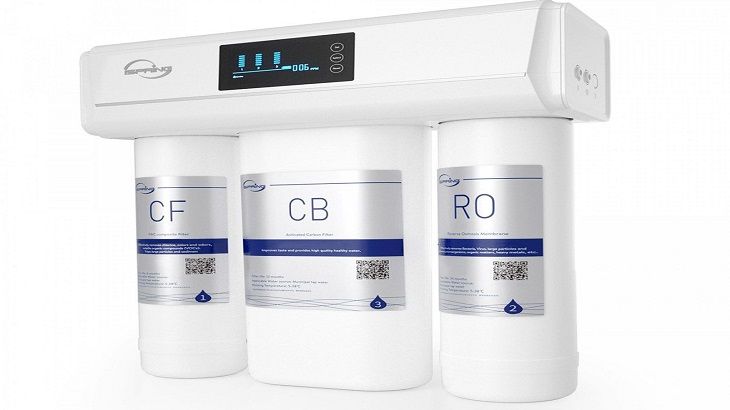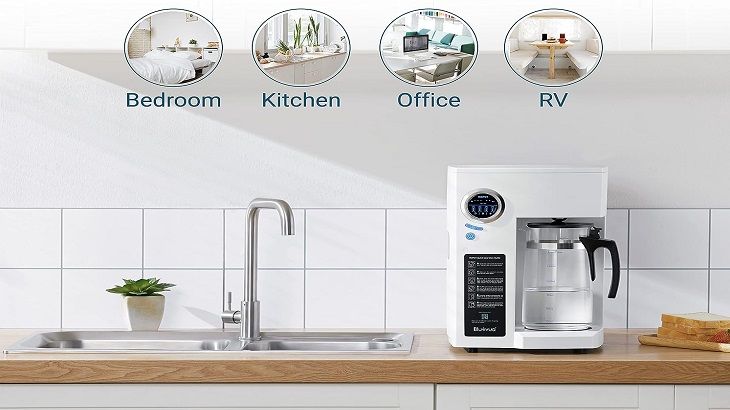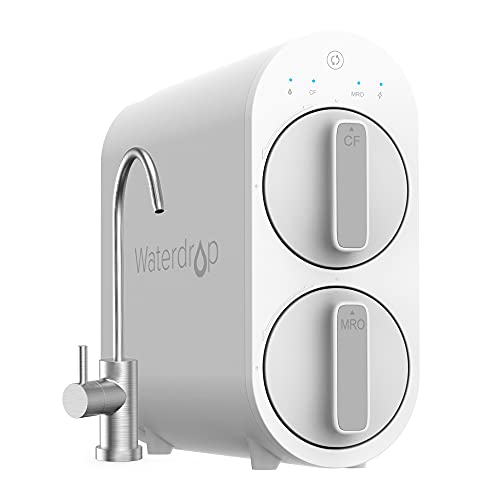Best Reverse Osmosis System For Your Kitchen - Review & Buying Guide
Michael Greene Jul 14, 2025 8:45 PM
Reverse osmosis (RO) produces pure, great-tasting water, making it one of the most efficient water filtering techniques. There are many choices for choosing the best reverse osmosis system for your house. So which one is the best?
Before buying a RO system, you need to consider its power, size, price, and many factors. Each of them affects how the machine serves your purpose.
I will recommend the highest-ranked RO systems available on the market. You can also learn a detailed buying guide to make an informed decision.
Let's follow my post to discover!

Types Of Product
Countertop and under-counter systems are your major choices when shopping for a reverse osmosis system.
Countertop
Countertop systems are exactly what they sound like—they rest on a countertop or the floor. Theoretically, these are standalone Reverse Osmosis systems.
Because these models are compact, you won't need to sacrifice a lot of counter space. Additionally, you won't need to worry about a laborious installation.

Countertop systems are the best option for renters who can't make long-term installations in their houses. You can also go for these machines if you don't want to hire a specialist to set up the system.
Under-counter
You put these reverse osmosis systems under the sink, hence the name. After setting up, you just need to turn on the faucet to let the system work.
Using the machine is simple, but installing it may be tricky. Many users have to seek out expert assistance for this step.

However, because under-counter machines can swiftly filter large volumes of water, they are actually the most practical choice for daily use.
-
Waterdrop G3 Reverse Osmosis System - Best Overall
-
Home Master HydroPerfection System - Best For Well Water
-
EXPRESS WATER Water Filtration System - Best For Drinking Water
-
SimPure Water Filtration Purification System- Best Countertop System
-
Waterdrop Under Sink Filter System - Best Under Counter System
After choosing the type of RO system, you will consider other important factors. It would be best to find a product that meets all these requirements.
Plumbing Requirements
Start by taking a look under your kitchen sink. An RO system occupies a lot of space since it employs several filters and a sizable storage tank. Thus, you may need to remove some items kept underneath your sink.
Water Output
A RO faucet may quickly supply water. However, it fills the storage tank at a speed of roughly 50 gallons per day, which is relatively slow. This figure equals a water production of around one gallon per 30 minutes.
Consider investing in a high output machine to provide up to 90 gallons of filtered water per day for a household with numerous water demands. A tankless system, which supplies up to 400 gallons of cleaned water, is also a good option.
Wastewater
Standard filters eliminate solid impurities as the water flows through them. However, RO filters remove such impurities in liquid form, leaving brine—a kind of wastewater.
Often, an RO system produces a staggering amount of wastewater when purifying 3 to 25 gallons. In light of this, search for systems with low wastewater to refined water ratios. The pure-to-drain ratio of 5:1 of this SimPure Water Purification System is impressive.
Tank Size
The size of a RO storage tank can be confusing. It ranges from 3 to 14 gallons.
Since storage tanks contain a metal bladder and an air bubble, the actual capacity will be less than what the tank is designed to store.
Depending on the airflow within the tank, the actual volume of water it can store may vary. A 4.5-gallon tank, for instance, may contain around two to three gallons of water.
High-Pressure Pump
We use PSI (pound per square inch) to estimate the water pressure in an RO system. A minimum of 50 PSI is standard for the machine.
Water pressure in most homes varies from 30 to 80 PSI. This high pressure is necessary to force the water through several RO filters while keeping the pressure adequate.
An RO booster pump boosts the water pressure to up to 80 PSI for households without high pressure. This EXPRESS WATER System is good enough for the task.
Besides, since an RO system performs better at this range or above, even houses that use the standard municipal water pressure of 60 PSI will benefit from a water pump.
Valves
After going through a filter and into the tank, water enters the purifying system. When the tank becomes full, a system's shut-off valve stops water from traveling back into the membrane.
This spring-operated valve successfully keeps the water in the tank by blocking the water back against the RO Membrane after the tank has been full.
When the air pressure in the tank is low enough to let water once more enter the system, the valve immediately reopens. While tiny and low-cost, this valve is essential for the RO system to work properly.
Ease of Installation
Most people, especially if you purchase under-counter machines, will prefer to hire an expert to install their RO system.
The cost you must spend for the job will depend on how complex the setup is. If you want to cut costs, buy a straightforward system instead.
Cost
The cost of an RO filter can range from $150 to more than $1000. The majority fall in the $250 to 500 range.
If you purchase a filter at the low end of the pricing range, you can end up with an item made of defective materials that aren't efficient or last you very long.
Many products in this budget range will suffice for the demands of most consumers. The higher-end alternatives, meanwhile, can include a few more nice-to-have features.
- GB SCORE-
GB SCORE is a ranking system developed by Guessbest.com. Guessbest.com has no relationship or impact from any manufacturers or sales agent websites. Learn more
- BrandWaterdrop
- GB SCORE-
GB SCORE is a ranking system developed by Guessbest.com. Guessbest.com has no relationship or impact from any manufacturers or sales agent websites. Learn more
- BrandWaterdrop
- GB SCORE-
GB SCORE is a ranking system developed by Guessbest.com. Guessbest.com has no relationship or impact from any manufacturers or sales agent websites. Learn more
- BrandWaterdrop
- Prime
- GB SCORE-
GB SCORE is a ranking system developed by Guessbest.com. Guessbest.com has no relationship or impact from any manufacturers or sales agent websites. Learn more
- BrandiSpring
- Prime
- GB SCORE-
GB SCORE is a ranking system developed by Guessbest.com. Guessbest.com has no relationship or impact from any manufacturers or sales agent websites. Learn more
- BrandiSpring
- GB SCORE-
GB SCORE is a ranking system developed by Guessbest.com. Guessbest.com has no relationship or impact from any manufacturers or sales agent websites. Learn more
- BrandEXPRESS WATER
- GB SCORE-
GB SCORE is a ranking system developed by Guessbest.com. Guessbest.com has no relationship or impact from any manufacturers or sales agent websites. Learn more
- BrandEXPRESS WATER
- GB SCORE-
GB SCORE is a ranking system developed by Guessbest.com. Guessbest.com has no relationship or impact from any manufacturers or sales agent websites. Learn more
- BrandBluevua
- Prime
- GB SCORE-
GB SCORE is a ranking system developed by Guessbest.com. Guessbest.com has no relationship or impact from any manufacturers or sales agent websites. Learn more
- BrandSimPure
- GB SCORE-
GB SCORE is a ranking system developed by Guessbest.com. Guessbest.com has no relationship or impact from any manufacturers or sales agent websites. Learn more
- BrandSimPure
- Prime
- GB SCORE-
GB SCORE is a ranking system developed by Guessbest.com. Guessbest.com has no relationship or impact from any manufacturers or sales agent websites. Learn more
- BrandSimPure
- Prime
- GB SCORE-
GB SCORE is a ranking system developed by Guessbest.com. Guessbest.com has no relationship or impact from any manufacturers or sales agent websites. Learn more
- BrandBluevua
- Prime
- GB SCORE-
GB SCORE is a ranking system developed by Guessbest.com. Guessbest.com has no relationship or impact from any manufacturers or sales agent websites. Learn more
- BrandBluevua
- Prime
- GB SCORE-
GB SCORE is a ranking system developed by Guessbest.com. Guessbest.com has no relationship or impact from any manufacturers or sales agent websites. Learn more
- BrandFRIZZLIFE
- Prime
- GB SCORE-
GB SCORE is a ranking system developed by Guessbest.com. Guessbest.com has no relationship or impact from any manufacturers or sales agent websites. Learn more
- BrandAquasana
- Prime
- GB SCORE-
GB SCORE is a ranking system developed by Guessbest.com. Guessbest.com has no relationship or impact from any manufacturers or sales agent websites. Learn more
- BrandAPEC Water Systems
- Prime
- GB SCORE-
GB SCORE is a ranking system developed by Guessbest.com. Guessbest.com has no relationship or impact from any manufacturers or sales agent websites. Learn more
- BrandHome Master
Last update on 2025-07-14 / Affiliate links / Images, Product Titles, and Product Highlights from Amazon Product Advertising API
1. How does a Reverse Osmosis System work?
The system works by using pressure to push water through a membrane. It only allows the water molecules to flow while blocking bigger molecules, like viruses or bacteria, from passing.
2. How can I sanitize a reverse osmosis system?
The instructions for cleaning your RO machine are as follows:
-
Stop the water supply to the system.
-
Depressurize the system by opening the faucet, then detach the membrane and filters.
-
Put a sanitation packet in the filter's housing.
-
Let the water run back through the system.
-
Reverse the water flow and operate the faucet to empty the system when the tank becomes full.
-
Repeat the process until the system is completely clean.
You can learn more cleaning tips right here:
3. How often do I need to replace the filter in my reverse osmosis system?
You should do the replacement of RO filters once every 12 months. Maintenance will guarantee that your entire RO system operates at its optimum efficiency. If not, there will still be pollutants in your drinking water.
4. Which is better for you, reverse osmosis or distilled water?
The distillation system can't completely eliminate Chlorine, herbicides, and pesticides. As a result, RO filtration systems are better at purifying water.
I have tried many RO systems, and some satisfy my requirements in all terms. I highly recommend this Waterdrop G3 Reverse Osmosis System because of its outstanding filtration performance and brilliant display faucet.
SimPure Water Filtration Purification System will be a better choice if you need a countertop filtration system. It's easy to install and has a fantastic purification performance.
Have you found the best RO system for your kitchen? Don't hesitate to contact me if you need any further information. Thank you for reading!
Read more:

































